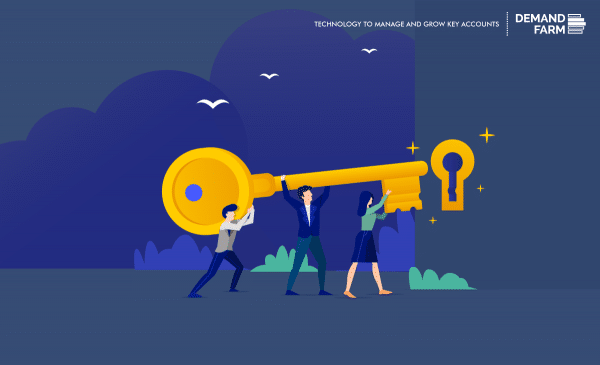Maintaining and building key account relationships with your partners and clients requires creating an emotional bond with them. B2C brands seem more aligned with this emotional connection with the consumers in the business world.
For the most part, B2B business decisions are influenced by a board of directors, corporate consultants, purchase managers, budget restrictions that have a tiring process of approvals, making the bond rather complicated.
So why even bother?
We as humans and professionals need to remember that emotional forces are inevitably present wherever we are trying to work together to make a decision. Whether it be a sales team or directors of a firm coming to a management decision.
This is especially important for key accounts that you want to build a long-lasting relationship with and take that extra step that goes beyond regular transactions and monthly reports. It is essential to understand the kind of role each account plays in your business and use that information to focus and invest accordingly to reach an account’s full potential.
Sounds contradictory to what we know? Here’s more
Google and CEB’s Marketing Leadership Council conducted a study with a marketing research firm Motista and surveyed 3,000 purchasers of 36 B2B brands across different industries. They found out B2B brands drive more emotional connections than B2C brands.
Most B2C brands studied by Motista were falling under a 10%-40% mark in emotional connection. With that said, they found that out of nine of the B2B brands they studied, seven surpassed the 50% mark. This tells us B2B brands are significantly more emotionally connected to their partners than consumers. B2B partnership in our age is treated as a transactional and rational activity.
No one wants anyone to believe that something as sentimental as emotions can drive decisions even though there is enough evidence present about all these human decisions being driven by a feeling of gut, emotions, and reasoning behind it. What’s even more appalling is that a lot of organizations make the mistake of treating each of their accounts with the same level of investment both in terms of emotions and resources.
Further, Let us quote Jonathan Haidt from his book, the happiness hypothesis to better understand this concept “that our emotional side is the Elephant and our rational side is the rider. Perched atop the Elephant, the Rider holds the reins and seems to be the leader. But the Rider’s control is precarious because the Rider is so small relative to the Elephant. Anytime the six-ton Elephant and the Rider disagree about which direction to go, the Rider is going to lose. He’s completely overmatched.
To elaborate, here’s the rider represents the conscious, rational mind while the elephant represents the unconscious, emotional mind that cannot be controlled by the rider’s force. In our example, the rider here is the B2B buyer trying to make a rational decision but often influenced by gut feelings and emotions (the elephant)—whether consciously or not.
While every partnership progresses along the way, the emotional aspect is an important factor along all the different stages of the account namely tactical, cooperative, interdependent as well as strategic. Now that we have understood the importance of emotions in our decision-making and the idea of not treating your partner as a pay-check, let’s jump to how you can leverage these emotions to create and maintain great partner relationship mapping. Sounds exciting now, doesn’t it?
1. Belief and a sense of responsibility
Agreements and contracts are made to protect oneself from the negative implications that can arise out of business transactions. They are in no way a driving factor in achieving extraordinary and ambitious decisions. Having a business partner invested in your targets and goals as much as you are invested in theirs creates a parallel army moving towards the same goals with clear expectations and direction. This doubles the chances of acquiring a more mutually beneficial business at the least. Such a shift in nature can be attained by using simple methods that increase engagement between the partners such as:
- Being open – To build lasting relationships, partners must completely rely on you as an expert. It is important to keep your point of view intact in the best interest of both parties and not get succumbed to agreeing to your partner even when your views differ.
- Being Appreciative – The simple act of being appreciative can boost productivity, thus improving work quality and producing better returns. This can be in the form of more sales or revenue while creating a happier environment in general.
- Positive attitude – Having a positive outlook on the outcomes of your business keeps the interest of the partner alive in the project and builds goodwill. It’s important to maintain a silver lining even at times of bad news. This way the focus stays on increasing the business performance rather than focusing on the negatives.
2. Change comes easier
We all know change is the only constant in every aspect of business yet we resist it because of its nature of unpredictability and uncertainty. Without change, growth stalls, and before you know it, you are doomed to fail. In this ever-evolving world of consumers, tastes and preferences change every few years at the most. The businesses that encourage and practice change, come out on the top.
C=Confidence, T=Trust, and L=Loyalty built over time between partners helps in making these strategic changes quicker leading to better performance. This combination of CTL can be achieved by:
- Transparency – Being transparent means showing your vulnerabilities, your strengths and weaknesses, and the actual assessment of the present status of your firm. You and your partner being clear about what you can offer at any given situation in the pipeline helps in creating the right expectations and goals that are attainable in there true nature.
- Healthy Conflict/Confrontation– Conflicts should not be avoided in any business scenario. It is for these conflicts that the best ideas come to life. Maintain an equilibrium by keeping your partner’s interests in mind and looking out for them first.
- Excellent communication– Communication can fall by when everyone is busy getting the work done. Each partner possesses unique knowledge about what works for them and what does not. Leveraging that with thoughtful communication makes it easy for each of them to discuss ideas, methods, and tactics for selling their products better
3. They have your back
Every business has its ups and downs, whether you see top-tier firms like apple or google or any other business which is out there to make a living. When at times your performance is below par or you are in need, a little push from your partner in their efforts can make a huge impact on the overall health of the business. This helps you flourish in your “bad days” and turn to achieve more with your partner in the long run.
This kind of surreal partnership leads to a long-term bond where both parties work up to their potential even when they are not remunerated up to the mark for their efforts. This is especially applicable in the interdependent relationship stage of the relationship. They also have your back in promoting your business through word of mouth.
They will happily become your marketing agents and introduce your business to their friends and relatives. A customer reached via word of mouth is a solid prospective partner as they already know about your performance and are looking for a partner that will deliver just that. It is of course essential to remember that it’s not always easy to be as invested in every account, which is where key account management plays an essential role.
To reiterate the famous management rule, 80% of profits can come from 20% of accounts. It’s not always easy to achieve the above three methods with each of your clients at every point in time. Strategic account management allows organizations to focus and invest personally and therefore understand and build a long-standing partnership entailing the recipe of success.
Conclusively, who does not like repeat business? Deals last with your business partners when you treat them as your own even before entering into it. The secrets to this are having a mix of six common factors which are empathy, chemistry, trust, respect, acceptance, and pleasure between the partners.
If you’re interested in transforming your sales post the pandemic, explore our blog on Sales Acceleration in Account Management and how it can help you grow your business in 2021.

